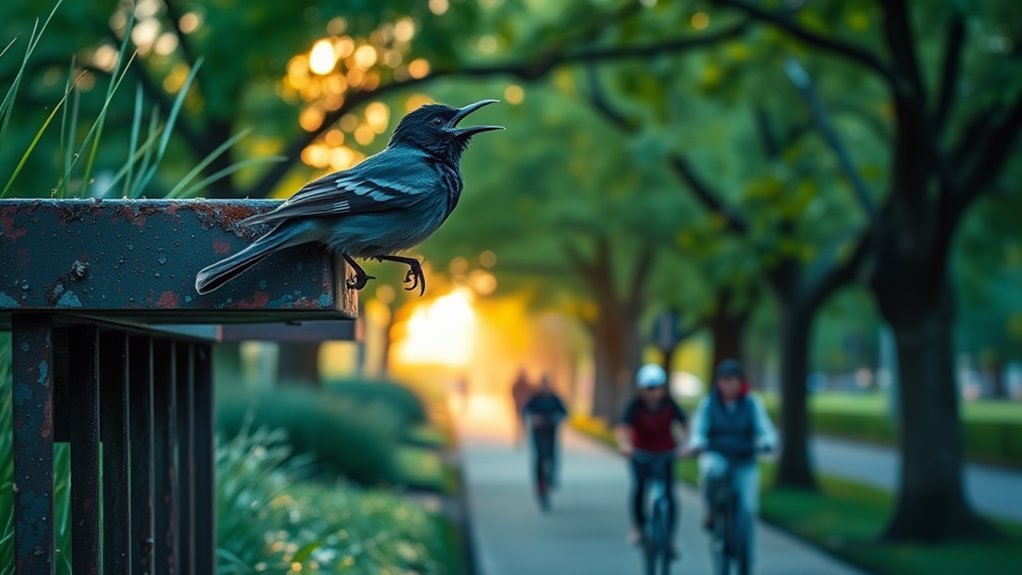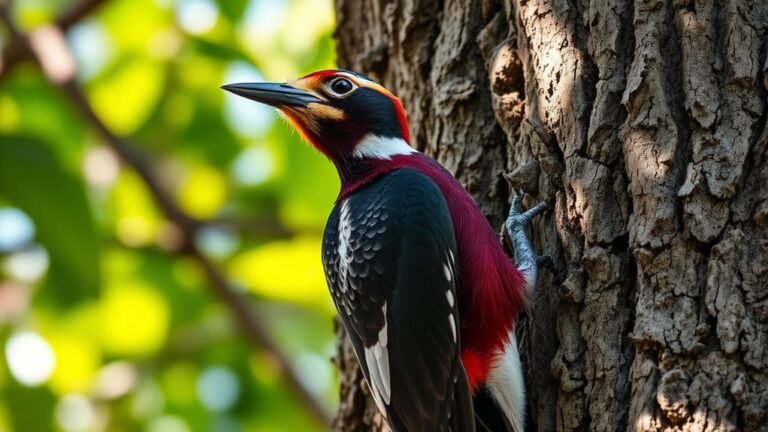What Bird Sounds Like a Car Alarm? Urban Noises Explained
As you walk through busy streets, you may hear birds imitating urban sounds, like car alarms. The European Starling and Red-Winged Blackbird are two examples of birds that can mimic these noises. This ability helps them adapt to city life. It raises interesting questions about their behavior and how they communicate with one another. Understanding this mimicry offers a glimpse into urban bird life and their interactions in our cities.
Key Takeaways
European Starlings imitate various sounds, including car alarms. They fit into city environments and add to the sounds around them.
Red-Winged Blackbirds can make calls that sound like car alarms, especially when competing with others.
Common Grackles produce loud, annoying calls that contribute to city noise.
Mockingbirds copy different sounds, potentially including noises similar to car alarms.
Bird mimicry helps them adapt to lively city life and thrive in urban settings.
The Mockingbird: Nature's Master Mimic
Have you heard a sound like a car alarm in the morning? You may have heard a mockingbird.
These birds imitate many sounds from their surroundings. They blend calls from other birds, animal noises, and even mechanical sounds into their songs. This mimicry helps them claim territory and attract mates.
Each mockingbird has its own unique set of sounds, shaped by its environment. Their songs create a connection with their surroundings, offering a rich and delightful sound experience.
Common Grackle: The Annoying Alarm
The common grackle has loud calls that stand out in urban areas. Its sharp screeches can be irritating.
This bird behaves confidently and often gathers in noisy groups. Grackles are common in city parks and parking lots, showing they adapt well to city life.
They search for food aggressively and sometimes take from other birds' nests or eat discarded food. Their bold presence changes the sounds of the city, making you think about how they claim their space.
The European Starling: A City Soundtrack
The European starling creates a unique sound in cities. Their whistles, clicks, and trills come from their ability to mimic sounds around them. They imitate car alarms, other birds, and more, fitting into city life well.
When you walk through busy streets, their songs provide comfort. They blend with the city's noise, reminding you that nature exists even in urban areas. The starlings connect you to the city's life. Their songs form a part of a larger, lively atmosphere.
The American Robin: A Versatile Vocalist
As spring arrives, you'll hear the joyful songs of the American Robin. Its melody combines sweet notes and trills, signaling the change of seasons.
The robin's behavior shifts as well. Observe the robins as they move between trees, their calls filling open areas. They modify their songs during nesting season, using softer notes to avoid attracting predators. This ability shows their adaptability.
As you listen, you feel a sense of connection to the vibrant life around you, celebrating the changes of the season and the beauty of nature.
The Red-Winged Blackbird: Territorial Calls
The Red-Winged Blackbird has a distinctive vocal style. Its sharp calls signal its presence and territorial claims.
When you hear its raspy notes in wetlands, it's often a male defending its space while trying to attract a mate. These birds perch on reeds and use loud sounds to deter rivals.
Their calls can remind you of car alarms, cutting through urban noise. Each call has purpose, as males compete for territory and connection with others.
Observing them offers insight into their strong instincts for survival and reproduction.
Urban Adaptations: Birds in High-Rise Areas
Urban environments can seem unwelcoming to wildlife. However, many bird species thrive in high-rise areas. Pigeons and sparrows often use ledges for nesting, turning busy streets into lively habitats.
These birds skillfully navigate around tall buildings to find shelter and food. If you pay attention, you may see them darting between balconies, showcasing their resilience.
Birds in cities adopt different nesting strategies. Some create nests from found materials, while others opt for simpler options.
Observing these urban birds highlights their ability to adapt. Their efforts reflect a common drive for survival that we all share.
Listening in the City: Tips for Bird Identification
City life can make it hard to hear nature sounds, but you can still identify many bird calls in the urban environment.
Start by learning about common birds in your area. Focus on their unique sounds. Each bird has a distinct call with specific patterns. Use a smartphone app to help you recognize these sounds and match them to the birds you see.
Listen during the early morning. This is when many birds are most active and vocal.
Joining local birdwatching groups can enrich your learning experience. Sharing your observations with others can increase your enjoyment of birdwatching.
Frequently Asked Questions
Can Urban Birds Distinguish Between Different City Sounds?
Urban birds can tell apart different sounds in the city. They learn to recognize sounds that signal danger or help them communicate with each other. This ability helps them adjust to busy city life.
What Is the Purpose of Bird Calls in Urban Environments?
In urban areas, bird calls serve important functions. They help birds communicate with each other, mark their territories, attract mates, and send warnings to others. Each call is shaped by the specific challenges that birds encounter in city life. Understanding these calls adds to our appreciation of how birds adapt to their environments.
How Do Birds Adapt to Noise Pollution?
Birds adapt to noise pollution through specific strategies. They may change their calls to be heard over background sounds. They also alter their behaviors to survive in loud environments. These adaptations help them thrive in urban settings. Birds show resilience and find ways to coexist with urban noise.
Are Certain Birds More Prevalent in Noisy Cities?
In noisy cities, common urban birds like pigeons and sparrows adapt their sounds to be heard over the noise. These birds thrive in loud environments. Their ability to change their vocalizations helps them survive and succeed in bustling areas. People often see these adaptable species in parks and streets, showcasing how they can live alongside human activity.
Do Bird Calls Change in the Presence of Humans?
Bird calls change when humans are nearby. Birds may call more often to be heard over city noise. This shows how they adapt and blend their sounds into our daily lives. They call to connect and communicate, making their melodies part of our bustling environment. It's interesting to see how they respond to human presence.

Ava is a bird enthusiast and nature lover who has spent countless hours observing and learning about the fascinating world of birds. With a passion for sharing her knowledge and inspiring others to appreciate the beauty of birds, Ava writes about her experiences and insights on avianadmirer.com.







